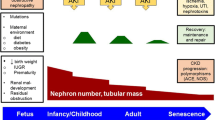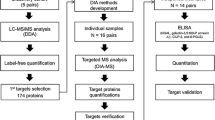Abstract
One out of every five children suffering from ureteropelvic junction obstruction (UPJO) requires pyeloplasty. This prevalence indicates an urgent necessity to identify high-grade UPJO as early as possible to avoid renal damage. A novel non-invasive proteomic urine test has recently been introduced that is able to detect these patients at an early stage. In the study reported here, we tested this approach to assess its use in our centre and to expand its application to older children. Twenty-seven children (median age 0.4 years, range 0.1–8.8 years) with hydronephrosis who had been scheduled a nuclear diuretic renal scan (DR) to identify urodynamically relevant UPJO were included in our prospective study. Patients with prior surgery of the urinary tract were excluded. The urinary proteome pattern was analysed using capillary electrophoresis coupled to mass spectrometry. Of the 27 children, 11 had a relevant UPJO diagnosed by the DR. In 19 children <1 year of age, urinary proteome analysis predicted obstruction with a sensitivity of 83% (5/6) and a specificity of 92% (12/13). However, in older patients, the sensitivity decreased to 20% (1/5) and specificity to 66% (2/3). Based on our results, the proteome pattern established by Decramer and co-workers predicts the need for surgery in infants but not in older children with UPJO.


Similar content being viewed by others
References
O’Flynn KJ, Gough DC, Gupta S, Lewis MA, Postlethwaite RJ (1993) Prediction of recovery in antenatally diagnosed hydronephrosis. Br J Urol 71:478–480
Grasso M, Gitlin J (2001) Ureteropelvic junction obstruction. eMedicine (serial online). Available at http://www.emedicine.com/med/topic3074.htm
Lam JS, Breda A, Schulam PG (2007) Ureteropelvic junction obstruction. J Urol 177:1652–1658
Woolf AS, Winyard PJD, Hermanns MM, Welham JM (2003) Maldevelopment of the human kidney and lower urinary tract: an overview. In: Vize P, Woolf AS, Bard JBL (eds) The kidney: from normal development to congenital disease. Academic, San Diego, pp 377–393
Heinlen JE, Manatt CS, Bright BC, Kropp BP, Campbell JB, Frimberger D (2009) Operative versus nonoperative management of ureteropelvic junction obstruction in children. Urology 73:521–525
Decramer S, Bascands JL, Schanstra JP (2007) Non-invasive markers of ureteropelvic junction obstruction. World J Urol 25:457–465
Csaicsich D, Greenbaum LA, Aufricht C (2004) Upper urinary tract: when is obstruction obstruction? Curr Opin Urol 14:213–217
Eskild-Jensen A, Gordon I, Piepsz A, Frøkiaer J (2005) Congenital unilateral hydronephrosis: a review of the impact of diuretic renography on clinical treatment. J Urol 173:1471–1476
Chevalier RL, Peters CA (2003) Congenital urinary tract obstruction. In: Proc State-of-the-art Strategic Planning Workshop. Pediatr Nephrol 18:576–606
Furness PD III, Maizels M, Han SW, Cohn RA, Cheng EY (1999) Elevated bladder urine concentration of transforming growth factor-beta1 correlates with upper urinary tract obstruction in children. J Urol 162:1033–1036
El-Sherbiny MT, Mousa OM, Shokeir AA, Ghoneim MA (2002) Role of urinary transforming growth factor-beta1 concentration in the diagnosis of upper urinary tract obstruction in children. J Urol 168:1798–1800
Taha MA, Shokeir AA, Osman HG, Abd El-Aziz Ael A, Farahat SE (2007) Pelvi-ureteric junction obstruction in children: the role of urinary transforming growth factor-beta and epidermal growth factor. Br J Urol Int 99:899–903
Grandaliano G, Gesualdo L, Bartoli F, Ranieri E, Monno R, Leggio A, Paradies G, Caldarulo E, Infante B, Schena FP (2000) MCP-1 and EGF renal expression and urine excretion in human congenital obstructive nephropathy. Kidney Int 58:182–192
Taha MA, Shokeir AA, Osman HG, Abd el-Aziz Ael A, Farahat SE (2007) Diagnosis of ureteropelvic junction obstruction in children: role of endothelin-1 in voided urine. Urology 69:560–565
Decramer S, Wittke S, Mischak H, Zürbig P, Walden M, Bouissou F, Bascands JL, Schanstra JP (2006) Predicting the clinical outcome of congenital unilateral ureteropelvic junction obstruction in newborn by urinary proteome analysis. Nat Med 12:398–400
Wong DC, Rossleigh MA, Farnsworth RH (2000) Diuretic renography with the addition of quantitative gravity-assisted drainage in infants and children. J Nucl Med 41:1030–1036
Schwartz GJ, Muñoz A, Schneider MF, Mak RH, Kaskel F, Warady BA, Furth SL (2009) New equations to estimate GFR in children with CKD. J Am Soc Nephrol 20:629–637
Schwartz GJ, Furth SL (2007) Glomerular filtration rate measurement and estimation in chronic kidney disease. Pediatr Nephrol 22:1839–1848
Zürbig P, Decramer S, Dakna M, Jantos J, Good DM, Coon JJ, Bandin F, Mischak H, Bascands JL, Schanstra JP (2009) The human urinary proteome reveals high similarity between kidney aging and chronic kidney disease. Proteomics 9:2108–2017
Mesrobian HG (2008) The value of newborn urinary proteome analysis in the evaluation and management of ureteropelvic junction obstruction: a cost-effectiveness study. World J Urol 27:379–383
Vlajković M, Ilić S, Rajić M, Petronijević V, Bubanj T, Artiko V (2005) Diuresis renal scintigraphy “F-0” in diagnosing of upper urinary tract obstruction in children: the clinical significance. Nucl Med Rev Cent East Eur 8:21–27
Author information
Authors and Affiliations
Corresponding author
Additional information
Jens Drube and Petra Zürbig contributed equally to this work.
Rights and permissions
About this article
Cite this article
Drube, J., Zürbig, P., Schiffer, E. et al. Urinary proteome analysis identifies infants but not older children requiring pyeloplasty. Pediatr Nephrol 25, 1673–1678 (2010). https://doi.org/10.1007/s00467-010-1455-8
Received:
Revised:
Accepted:
Published:
Issue Date:
DOI: https://doi.org/10.1007/s00467-010-1455-8




